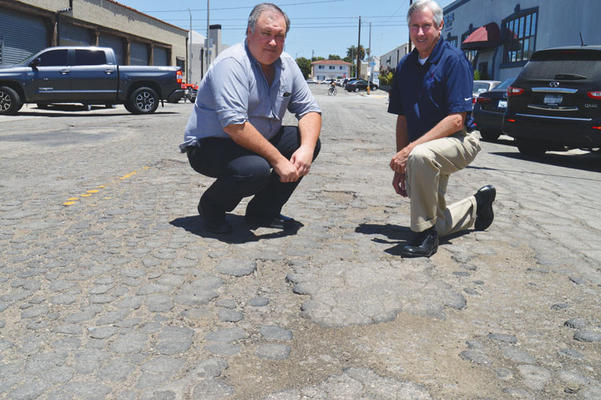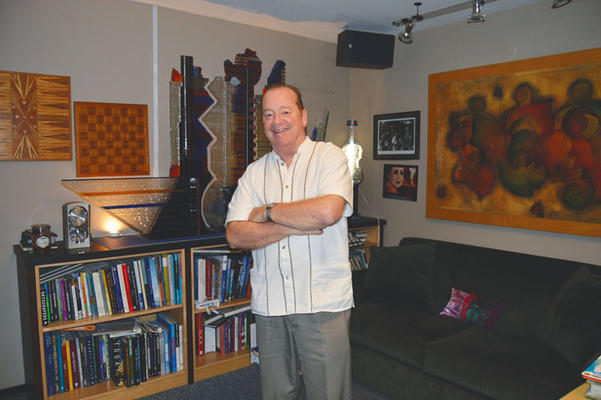With about 300 businesses located within the Magnolia Industrial Group area just east of the Los Angeles River (bounded by Magnolia Avenue, Anaheim Street and Pacific Coast Highway) and another 400-plus businesses west of the river in the Westside industrial area (to the city’s western boundary, from the port to just past Pacific Coast Highway), substantial tax revenue is generated for the city in that area alone. Many of these businesses, however, feel marginalized by city officials.
“It’s not that they overlook the Westside a lot. They overlook the Westside, period,” Daryl Phillips, president of Phillips Steel Company, said. “The Westside doesn’t have a relationship with the city. But relationships help resolve this, [that is] having an understanding of the neighborhood.”

Mike Zupanovich, left, co-owner of Harbor Diesel & Equipment Inc. and a boardmember of the Magnolia Industrial Group (MIG), and Bill Townsend, president of MIG and INCO Commercial Realty, said Westside infrastructure has been neglected for too long and the roads are crumbling. The two are pictured on 15th Street between Daisy and Oregon avenues. (Photograph by the Business Journal’s Larry Duncan)
Phillips said that city officials will listen to the concerns and complaints of Westsiders but that the wheels of action move very slowly when it comes to taking action and resolving problems, which he said is frustrating. However, he explained that business owners take this fact with a grain of salt because the area is such a great place to conduct business overall.
Concerns about the future of the Westside have been festering in recent months. Phillips noted the Port of Long Beach’s proposed Pier B on-dock rail yard as a primary concern of Westsiders. Additionally, homelessness, dilapidated streets, crime, parking and flood control are all issues Westside business owners face on a daily basis, according to Phillips.
“I don’t like a negative vent unless there is good that comes from it and positive action to take,” Phillips said. “The reality is that it is a great place to do business. Every neighborhood has its issues – industrial, commercial, residential. There’s no question about that.”
Mike Zupanovich, co-owner of Harbor Diesel & Equipment Inc. and a boardmember of the Magnolia Industrial Group (MIG), said his number one concern is the crumbling infrastructure of the Westside.
“The streets are just absolutely deplorable,” Zupanovich said. “The city is throwing good money after bad by patching streets because they’re just falling apart – they are beyond their life. They say they have them in the plans and Measure A. Well, we’ll see. Everything is ‘down the road.’”
City officials do not focus on enhancing the business climate but rather on social issues, according to Zupanovich. He noted that the city does respond to calls for service for situations such as illegal dumping in a timely manner, which he appreciates. But he explained that he gets frustrated speaking with well-meaning city officials focused on social issues when tax revenue- generating businesses are in need of their time as well.
Zupanovich said that city officials are not working and living in the Westside area, so they do not see the need on a daily basis. If they did, he said they would see that they can do a better job. If they did, they would notice the overgrown weeds and ugly-looking facades and facilities and the potholes large enough to “swallow up a Prius.”
“What thing has the city done to help businesses out recently? I can’t answer for what they’ve done for neighborhoods that are industrial,” Zupanovich said. “I couldn’t tell you one thing. Everything is social issues and bike paths and all that stuff.”
Bill Townsend, president of MIG and INCO Commercial Realty, agreed with Zupanovich that the decrepit streets are in serious need of attention and investment. Townsend noted that being an industrial area, the Westside sees far more trucking activity, which puts an increased stress on streets when compared to other areas of the city.
The Westside has been very active for years, which has benefited Long Beach greatly, according to Townsend. In the MIG area specifically, Townsend said security has been greatly improved, which has reduced crime.
“We just need to continue to work with the city to address things as they come up and get them solved,” Townsend said. “There’s a lot of needs in the city, but you’ve got a very strong business community that seems to be doing a pretty good job. But if you want to look back on infrastructure, that is something we definitely need help with.”
For Paul Collins, owner of architecture firm PAC Design, the single greatest threat to Westside businesses is the port’s proposed rail yard, a project that Westsiders have banded together to oppose. Collins said Westside Project Area Council (West PAC) is focused on this issue to ensure Westside businesses continue to thrive and are not forced out.
“We’re meeting with other organizations – residential groups and business groups – that will be affected by that and trying to at least mitigate some of the issues that they are going to be creating, which is going to be very detrimental to businesses and residents on the Westside,” Collins said.
Regarding the rail yard, Phillips added that both the port and city officials appear to be working against Westsiders, rather than with them. He said business owners are trying diligently to open lines of communications in order to come to a suitable compromise. However, if the port is heeding the concerns of Westsiders, Phillips said they are not communicating that.
Increased homeless population is another concern, according to Collins. He explained that with the closure of Lincoln Park downtown, and due to the many development projects in the area, the homeless have been displaced, subsequently finding their way to the Westside.
“A lot of them tend to camp out at night because these businesses are closed and the streets are empty and there’s lots of little cubbyholes for them to hide and sleep,” Collins said. “And we’d like to see a better response by the police. The police don’t see it as a top priority unless someone is violent.”
Another major issue, according to Collins, is the oversized vehicles, namely motorhomes, that park on the Westside. He noted that what makes the problem so severe is that people are often living in these RVs and will stay in one spot for up to three days, as permitted by law. However, when they move, Collins said oftentimes sewage and trash is being dumped right on the streets and sidewalks, wreaking havoc on businesses.
What compounds the issue is the legality of not being able to tow these vehicles if the occupants are inside. Collins said that if police arrive to handle a vehicle that has exceeded the three-day period and the occupants do not come to the door, it causes a standoff and no action can be taken. This is a great annoyance to police and business owners alike, he said.
“The Westside generates a lot of taxes, but we sort of get the leftovers from the various departments,” Collins said. “It would be a lot better if we were paid better attention to, for sure.”
Collins acknowledges 1st District Councilmember Lena Gonzalez is an ally to Westsiders, having worked with them on various issues. But he said he thinks the area is not a top priority of city officials, most likely due to the fact that there are very few residents. He also noted that it is hit or miss as to whether the city will resolve a specific problem called in by a Westside business owner.
“My staff and I spend as much time as we can out on the Westside, attending the West PAC meetings regularly. I am always available to the Westsiders when they ask me to be,” Gonzalez said. “I know that some of them feel [excluded], and I know that there’s a large corridor that divides us. But there’s also a lot to come to the Westside that we’re working on, so we are excited about that.”
Gonzalez explained that her team has been working on a Santa Fe Corridor revitalization project that she will soon present as an agenda item at a city council meeting. She said she has encouraged Westsiders to share their hopes and visions for the area, saying that this is a time to think big.

Paul Collins, owner of architecture firm PAC Design, said the Port of Long Beach’s proposed Pier B on-dock rail yard is the greatest threat to Westside business owners. (Photograph by the Business Journal’s Larry Duncan)
As part of the revitalization process, Gonzalez said a community-rebranding program for the entire 1st District is already underway, which includes the Westside. This rebranding will include each neighborhood giving input on area enhancements, as well as neighborhood logos to be incorporated into the Santa Fe Corridor revitalization.
To address the oversized vehicle issue, the city is working on an ordinance to ban parking such vehicles in certain areas. The city council agenda item specifically referred to residential zones; however, Gonzalez said commercial and industrial zones would be included as well.
“The commercial corridors will be up to the discretion of our public works director. So it’s kind of a caveat in the ordinance,” Gonzalez said. “There’s still a commercial problem with RVs in those areas – [the department of] public works is very aware of that. So they’ll be making sure that they are adding that enforcement as well to specific hot spot commercial areas, like the Westside, like MIG, and I think some other areas outside of my district that have been hot spots for RVs.”
As far as infrastructure concerns and the need for street repairs throughout MIG and the Westside, Gonzalez said Measure A funds will be utilized for such enhancements in the coming years but that streets were prioritized in the pavement management plan, and the highest needs are being seen to first. She acknowledged that much of the identified need is in residential areas. She said she is working to make alleyway improvements a priority on the Westside as well.
Regarding the concerns over the increase of the Westside homeless population, Gonzalez said it is not a Westside issue but rather a citywide issue that is part of the growing pains of the city. She acknowledged how such a phenomenon can upset business but said the city will continue to work to assist with the problem. She also asked that businesses be more proactive in dealing with the situation as well, for a team effort to combat the social issue.
“I absolutely love spending time on the Westside. I’m very proud of the Westside,” Gonzalez said. “The Westside has some of the oldest and most historic businesses we have in the whole city. It’s really great that they decided to invest in Long Beach and that they are here to stay. I think we need to do even more to shed light on the Westside to make sure that people feel included in the whole city.”
Despite the issues and concerns facing the Westside in the near and long term, the business owners agreed that the area is a unique neighborhood and a great place to conduct their business. Though some business owners have admitted that they would leave if issues such as the port’s rail yard are not handled properly, those same businesses expressed a hope for compromise so they can stay.
“City management can help by taking a closer look and working with Westsiders,” Phillips said. “There’s no magic bullet. We’ve got to address all of the issues.”
